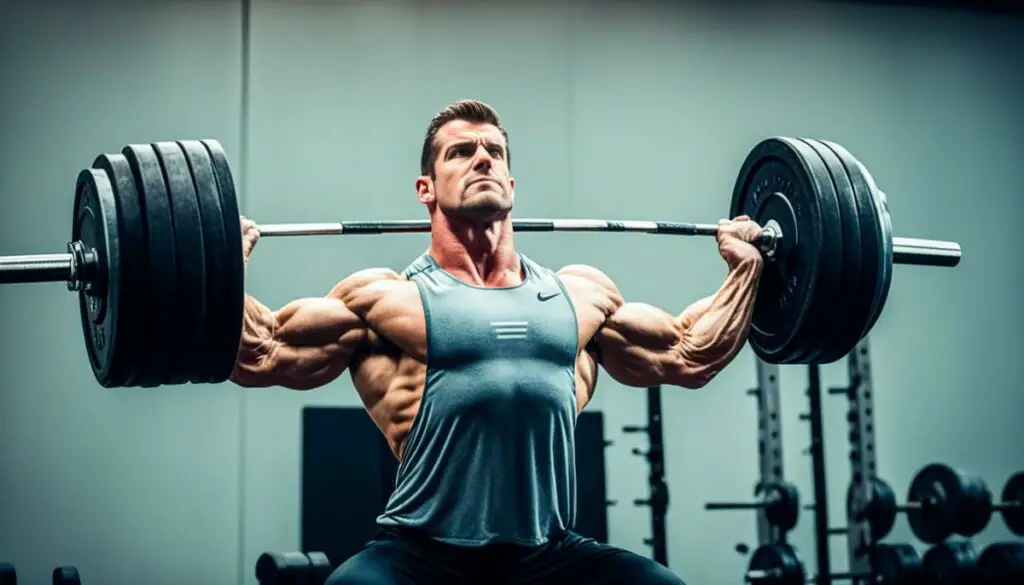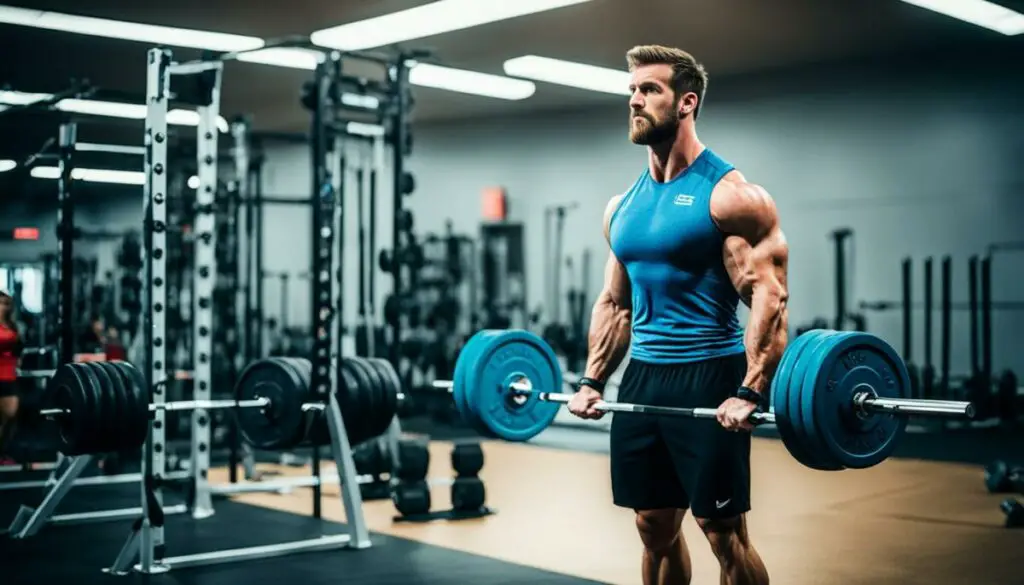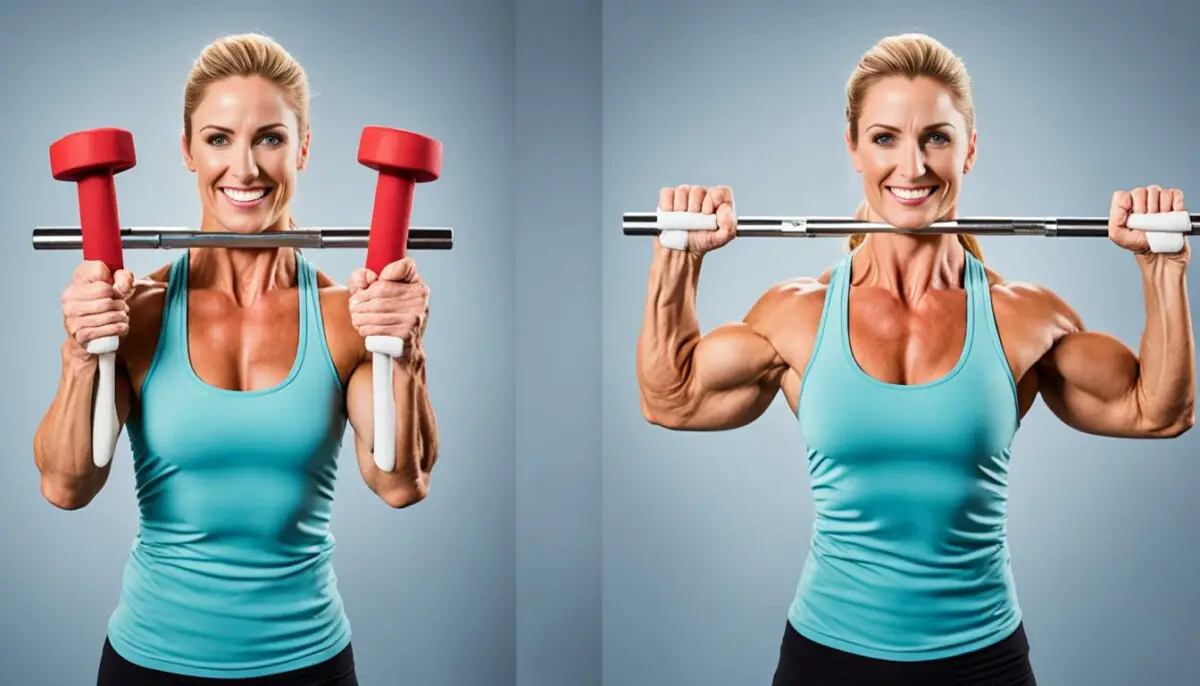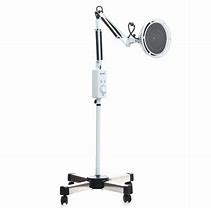Last Updated on 3 months by Francis
The trap bar deadlift and conventional deadlift are two popular variations of the deadlift exercise. Both exercises have their own unique advantages and considerations. In this article, we will compare the trap bar deadlift and conventional deadlift, discussing their differences, benefits, drawbacks, and when to choose one over the other.
The trap bar deadlift is a knee-dominant exercise that targets the quadriceps more intensely. It uses a hexagonal-shaped barbell that allows for a more upright torso position, reducing the strain on the lower back. On the other hand, the conventional deadlift is a hip-dominant exercise that recruits the glutes, hamstrings, lower back, and lats.
When considering the trap bar deadlift, it is worth noting that it is easier to learn, making it suitable for beginners. It also allows for heavier loads, making it beneficial for building strength. Additionally, the trap bar deadlift places less stress on the lower back, making it a safer option for individuals with previous injuries or lower back pain.
The conventional deadlift, on the other hand, is known for its effectiveness in strengthening the posterior chain, engaging the glutes, hamstrings, and lower back. It is a staple exercise in powerlifting competitions and can improve grip strength. However, it requires proper form and technique to minimize the risk of injury.
When deciding between the trap bar deadlift and conventional deadlift, it’s important to consider your goals and preferences. The trap bar deadlift may be more suitable for those looking to target their quads specifically or individuals with limited joint mobility. The conventional deadlift, on the other hand, is ideal for strengthening the lower back and targeting the posterior chain.
Ultimately, the choice between these two variations depends on your individual needs and training goals. It may also be beneficial to incorporate both exercises into your routine, alternating between them to provide a comprehensive lower body and back workout.
Contents
Key Takeaways:
- The trap bar deadlift and conventional deadlift are two variations of the deadlift exercise.
- The trap bar deadlift targets the quads more, while the conventional deadlift focuses on the posterior chain.
- The trap bar deadlift is easier to learn and places less stress on the lower back.
- The conventional deadlift is effective for strengthening the lower back and improving grip strength.
- The choice between the two depends on individual goals and preferences.
Main Differences Between Trap Bar Deadlift and Conventional Deadlift
When it comes to deadlift variations, the trap bar deadlift and conventional deadlift are two popular choices. Understanding their main differences can help you determine which one is best suited for your needs and goals. Let’s explore the key distinctions between these two exercises:
Trap Bar Deadlift:
- Uses a hexagonal-shaped barbell
- Allows for a more upright torso position
- Greater quad activation
Conventional Deadlift:
- Uses a straight barbell
- Has a hip-dominant movement pattern
- Targets the glutes, hamstrings, lower back, and lats
These differences in barbell type, body position, and muscle activation make the trap bar deadlift and conventional deadlift distinct variations. While the trap bar deadlift engages the quads and allows for a more upright position, the conventional deadlift emphasizes the posterior chain and involves a hip-dominant movement pattern.
To further illustrate these differences, here’s a visual comparison:
| Trap Bar Deadlift | Conventional Deadlift |
|---|---|
As you can see, the trap bar deadlift allows for a more upright position, while the conventional deadlift involves a more forward-leaning position.
Understanding these main differences can help you decide which deadlift variation aligns better with your training goals and preferences. Whether you prioritize quad development or posterior chain strength, incorporating the appropriate deadlift variation into your training routine can yield optimal results.
Benefits of Trap Bar Deadlift

The trap bar deadlift offers several benefits that make it a popular choice among fitness enthusiasts. Whether you’re a beginner or an experienced lifter, incorporating trap bar deadlifts into your training routine can yield significant results.
- Easier to Learn: The trap bar deadlift is known for its more vertical trajectory and upright body position, which makes it easier to learn, especially for beginners. This allows you to focus on proper form and technique without compromising your safety.
- Spine Safety: Compared to the conventional deadlift, the trap bar deadlift places less stress on the lower back, making it a safer option for individuals concerned about spinal health. The more neutral position of the trap bar reduces the risk of lower back injuries.
- Heavier Loads: The design of the trap bar allows you to lift heavier loads compared to the conventional deadlift. By distributing the weight more evenly and utilizing the strength of your legs, you can challenge your muscles and achieve greater strength gains.
- Quadriceps Targeting: The trap bar deadlift places a greater emphasis on the quadriceps compared to the conventional deadlift. This makes it an excellent exercise for individuals looking to develop strong, powerful legs.
- Sport-Specific Training: The trap bar deadlift mimics the movement patterns often required in various sports such as basketball, football, and track and field. By incorporating trap bar deadlifts into your training, you can improve your sport-specific performance and explosiveness.
- Suitability for Limited Mobility: Individuals with limited joint mobility or range of motion can benefit from the trap bar deadlift. This exercise requires less mobility in the hip and ankle joints compared to the conventional deadlift, allowing individuals with mobility limitations to safely perform the movement.
By incorporating trap bar deadlifts into your workout routine, you can enjoy these benefits and take your training to the next level.
Benefits of Conventional Deadlift

The conventional deadlift offers a wide range of benefits for individuals looking to strengthen their lower back and target their hip and back muscles. This variation of the deadlift places a heavy emphasis on hip hinging and engages several muscle groups, including the glutes, hamstrings, lower back, and lats.
One of the key advantages of the conventional deadlift is its ability to strengthen the lower back. The movement pattern involved in this exercise helps to develop strong spinal erectors, which are essential for maintaining proper posture and preventing lower back pain.
In addition to strengthening the lower back, the conventional deadlift also improves grip strength. As you lift heavier loads, your grip strength is challenged, leading to increased forearm and hand strength. This can have a positive impact on other exercises and daily activities that require grip strength.
The conventional deadlift is also a staple exercise in powerlifting competitions. It is one of the three main lifts in powerlifting, alongside the squat and bench press. By regularly incorporating the conventional deadlift into your training routine, you can improve overall strength and performance in powerlifting.
The conventional deadlift provides a more posterior-focused stimulus, making it an ideal choice for individuals looking to target their hip and back muscles. The activation of the glutes, hamstrings, lower back, and lats during this exercise helps to develop a strong and powerful posterior chain.
Overall, the conventional deadlift offers a variety of benefits, including strengthening the lower back, improving grip strength, and targeting the hip and back muscles. It is a versatile exercise that can be incorporated into various training programs to enhance overall strength and performance.
Drawbacks of Trap Bar Deadlift
While the trap bar deadlift offers many benefits, it also has a few drawbacks to consider:
- The trap bar deadlift may not fully engage the posterior chain as much as the conventional deadlift. The primary focus of the trap bar deadlift is on the quads, rather than targeting the glutes, hamstrings, and lower back like the conventional deadlift does.
- Another drawback is that the trap bar deadlift requires a specific type of barbell. This type of barbell may not be available in all gyms, limiting your ability to perform the exercise.
- The grip position in the trap bar deadlift is limited to a neutral grip. Some individuals prefer other grip options, such as the double overhand or mixed grip, which may not be possible with the trap bar. This limitation may not suit everyone’s preference or hand structure.
Despite these drawbacks, the trap bar deadlift can still be a valuable addition to your training routine, especially if you want to target your quads or if you have limitations that prevent you from performing the conventional deadlift.
Drawbacks of Conventional Deadlift

The conventional deadlift is a technically demanding exercise that requires proper form and technique to minimize the risk of injury. It places a greater load on the lower back, which can be problematic for individuals with lower back pain or limited back strength. The conventional deadlift may also cause shin scratches and bruises due to the barbell’s proximity to the body.
Proper form and technique are crucial when performing the conventional deadlift to protect the lower back.
“The conventional deadlift requires careful attention to technique to avoid injury and maximize results.”
When to Choose Trap Bar Deadlift vs Conventional Deadlift

The choice between the trap bar deadlift and conventional deadlift depends on individual goals and preferences. Understanding the differences and benefits of each exercise can help determine when to incorporate them into your workout routine.
Trap Bar Deadlift:
The trap bar deadlift is an excellent choice for beginners and individuals with limited joint mobility. Its more vertical trajectory and upright body position make it easier to learn and perform correctly. This variation is also ideal for those looking to target their quadriceps more intensely. The trap bar deadlift is a great exercise for sport-specific training and explosive movements.
Conventional Deadlift:
The conventional deadlift is beneficial for strengthening the lower back and targeting the posterior chain, including the glutes, hamstrings, and lats. Powerlifting competitions often include the conventional deadlift as a staple exercise. If your goal is to improve grip strength and focus on hip and back muscles, the conventional deadlift is a great choice.
Consider your fitness goals, training program, and specific needs when deciding between the trap bar deadlift and conventional deadlift. Some individuals may prefer one variation over the other, while others may incorporate both exercises into their routine for a more comprehensive lower body and back training regimen.
| When to Choose Trap Bar Deadlift | When to Choose Conventional Deadlift |
|---|---|
| Beginners | Powerlifting competitions |
| Individuals with limited joint mobility | Strengthening the lower back |
| Targeting quadriceps | Targeting posterior chain muscles |
| Sport-specific training | Improving grip strength |
Experimentation, proper form, and listening to your body are key factors in determining which deadlift variation is best suited for you. Incorporating the trap bar deadlift and conventional deadlift in your training can offer a well-rounded approach to building strength and improving overall fitness.
Ideal Trap Bar to Conventional Deadlift Ratio
When it comes to the ideal ratio between trap bar deadlift and conventional deadlift, there is no one-size-fits-all answer. The ratio will vary based on individual goals, training programs, and personal preferences. Some individuals may prefer to focus more on one variation over the other, while others may choose to incorporate both exercises into their training routine.
Listening to your body and assessing your goals are key factors in determining the right balance between trap bar deadlifts and conventional deadlifts. If your primary aim is to target your quads and improve overall strength, you may opt for a higher ratio of trap bar deadlifts. On the other hand, if you want to focus on strengthening your posterior chain and enhancing powerlifting performance, a higher ratio of conventional deadlifts may be more suitable.
“The ideal trap bar to conventional deadlift ratio is highly individualized, and it’s important to consider your specific goals and preferences before making a decision.” – Fitness Expert
By experimenting with different ratios and listening to how your body responds, you can find the balance that works best for you. It’s important to note that incorporating both variations or alternating between them can provide a comprehensive lower body and back training regimen.
Remember, there is no right or wrong answer here. The key is to find a ratio that aligns with your goals and enables you to maintain a well-rounded and effective training routine.
Trap Bar vs Conventional Deadlift Ratio Examples
| Goal | Ideal Trap Bar Deadlift to Conventional Deadlift Ratio |
|---|---|
| Primarily quad development | 80% trap bar deadlifts, 20% conventional deadlifts |
| Overall posterior chain strength | 20% trap bar deadlifts, 80% conventional deadlifts |
| Powerlifting performance | 70% conventional deadlifts, 30% trap bar deadlifts |
| Variety and balance | 50% trap bar deadlifts, 50% conventional deadlifts |
Technique and Tips for Trap Bar Deadlift
Proper form and technique are essential when performing the trap bar deadlift to maximize its benefits and reduce the risk of injury.
- Step inside the trap bar with your feet hip-width apart.
- Hinge your hips back, maintaining a slight bend in your knees.
- Grasp the handles of the trap bar with a neutral grip, keeping your wrists straight.
- Engage your core and glutes, and maintain a neutral spine throughout the movement.
- Lift the bar by explosively extending your hips and knees, driving through your heels.
- As you approach the top of the movement, squeeze your glutes to fully lock out your hips.
- Lower the bar under control, hinging at the hips and bending your knees to return to the starting position.
The trap bar deadlift can be performed with either high handles or low handles, each offering different benefits. Using high handles places less stress on the lower back and requires greater quad activation, while using low handles increases the range of motion and emphasizes the posterior chain.
Remember to breathe properly during the movement. Inhale deeply before initiating the lift and exhale forcefully as you exert effort to help stabilize your core.
It’s important to start with lighter weights and focus on mastering your form and technique before progressing to heavier loads. If you’re unsure about your technique, consider working with a qualified fitness professional to ensure proper execution.
Trap Bar Deadlift Tips
Here are some additional tips to enhance your trap bar deadlift:
- Keep your shoulders back and down to maintain a stable upper body.
- Avoid rounding or arching your back throughout the movement.
- Focus on pushing through your heels and driving your hips forward to generate power.
- Use a controlled tempo, emphasizing the eccentric (lowering) phase of the lift.
- Include progressive overload in your training by gradually increasing the weight lifted over time.
By practicing proper technique and incorporating these tips, you can optimize your trap bar deadlift and reap the full benefits of this effective exercise.
Conclusion
In conclusion, the trap bar deadlift and conventional deadlift are both highly effective exercises that offer unique benefits. The trap bar deadlift places greater emphasis on the quadriceps and is easier to learn, making it ideal for beginners or individuals with limited mobility. On the other hand, the conventional deadlift targets the posterior chain muscles, including the glutes, hamstrings, lower back, and lats, and requires more technical proficiency.
When choosing between the two variations, it is important to consider individual goals, preferences, and specific training needs. If you are looking to develop your quads, improve sport-specific performance, or prefer a more upright posture during the lift, the trap bar deadlift may be the better choice for you. Conversely, if your focus is on strengthening the posterior chain, targeting multiple muscle groups, or participating in powerlifting competitions, the conventional deadlift is recommended.
For a well-rounded lower body and back training regimen, it is beneficial to incorporate both trap bar and conventional deadlift variations. By alternating between these exercises, you can maximize muscle development, enhance strength, and minimize the risk of overuse injuries. It is important to experiment with different approaches, maintain proper form and technique, and listen to your body to determine which deadlift variation is best suited for you.
FAQ
What is the difference between the trap bar deadlift and conventional deadlift?
The trap bar deadlift is knee-dominant, targeting the quads more, while the conventional deadlift is hip-dominant, recruiting more glutes, hamstrings, lower back, and lats.
What are the benefits of the trap bar deadlift?
The trap bar deadlift is easier to learn, safer for the spine, allows for heavier loads, targets the quads more, and is suitable for individuals with limited mobility.
What are the benefits of the conventional deadlift?
The conventional deadlift strengthens the lower back, engages the glutes, hamstrings, lower back, and lats, improves grip strength, and is a staple exercise in powerlifting competitions.
What are the drawbacks of the trap bar deadlift?
The trap bar deadlift may not fully engage the posterior chain, requires a specific type of barbell, and has a limited grip position.
What are the drawbacks of the conventional deadlift?
The conventional deadlift places a greater load on the lower back, requires proper form and technique, and may cause shin scratches and bruises.
When should I choose the trap bar deadlift over the conventional deadlift?
The trap bar deadlift is ideal for beginners, individuals with limited joint mobility, those looking to target their quads more, and for sport-specific training.
When should I choose the conventional deadlift over the trap bar deadlift?
The conventional deadlift is beneficial for strengthening the lower back, targeting the posterior chain, and for powerlifting competitions.
What is the ideal trap bar to conventional deadlift ratio?
There is no specific ideal ratio as it varies depending on individual goals, training programs, and preferences.
What are some tips for performing the trap bar deadlift with proper technique?
Step inside the trap bar with your feet hip-width apart, hinge your hips, hold the handles with a neutral grip, and lift the bar by extending your hips and knees while maintaining a neutral spine.
What are the main takeaways from comparing trap bar deadlift and conventional deadlift?
The trap bar deadlift targets the quads more and is easier to learn, while the conventional deadlift focuses on the posterior chain and requires more technical proficiency. The choice between the two depends on individual goals, preferences, and specific training needs.








